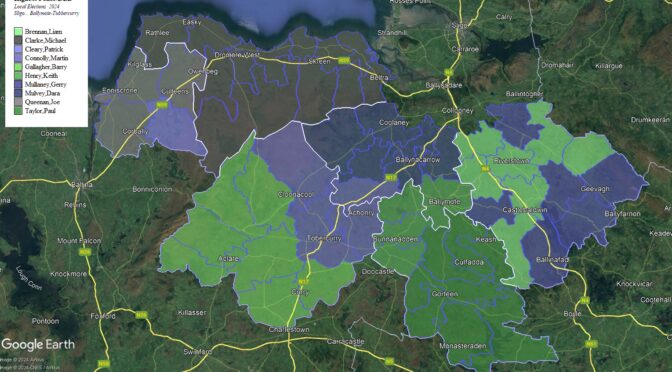Ballymote-Tubbercurry – essentially the whole of South Sligo – is one of the most “geographic” Electoral Areas as it is effectively bisected by the Ox Mountains with only one minor road running between the North-West and the rest of the area.
Two seats were elected in the east – Liam Brennan (FF) and Gerry Mullaney (FG), one in the South – Paul Taylor (FF), one in Ballymote – Dara Mulvey (FG) and one in Tubbercurry – Barry Gallagher (FF).
West of the Ox Mountains, Joe Queenan (IND) dominated the Enniscrone area close to the Mayo border, while Michael Clarke (IND) did similar further North around Dromore.
Fianna Fáil made a gain in the Tubbercurry area, with Gallagher narrowly edging out previous incumbent Martin Connolly of Fine Gael.
in 2014, Fianna Fáil pulled off a remarkable victory taking 5 out of eight seats with less than three and a half quotas.
This area has always been a weak spot for Fine Gael and their three candidates took just over half a quota between them and were never in contention.
| PARTY | VOTE | % | CHANGE % | SEATS | CHANGE | L.E.C. |
| Fianna Fáil | 5,537 | 34.25 | +2.73 | 3 | +1 | 36.91 |
| Fine Gael | 5,504 | 34.04 | +1.29 | 2 | -1 | 36.41 |
| Sinn Féin | 1,030 | 6.37 | +3.71 | |||
| Irish Freedom Party | 596 | 3.69 | +3.69 | |||
| PBP-Solidarity | 203 | 1.26 | +1.26 | |||
| Independents | 3,296 | 20.39 | -12.67 | 2 | 26.67 |
Note 1 – L.E.C stands for Last Effective Count
Both Fianna Fáil and Fine Gael gained votes, but it was Fianna Fáil gaining advantage in the Tubbercurry area that allowed them to take a seat at the expense of Martin Connolly of Fine Gael. Connolly in turn had only won by less than a hundred votes in 2019 from Independent Willie Gormley, nephew of veteran Councillor Margaret Gormley.

The Map above shows the poll-topper in each District Electoral Division – with the white line boundaries denoting the extent of each elected candidate’s vote catchment area.
The reason there is only six areas is because Liam Brennan’s and Gerard Mullaney’s vote in the Riverstown area is very much intertwined.
| COUNT | FROM | TYPE | F.F | F.G. | S.F. | I.F.P. | P.B.P. | Ind. | N.T. | Total |
| 2 | Hendrick (P.B.P.) | Elim. | 9.4% | 13.8% | 51.7% | 1.0% | 10.8% | 13.3% | 203 | |
| 3 | O’Connor (S.F.) | Elim. | 16.8% | 16.5% | 56.7% | 2.2% | 2.2% | 5.6% | 321 | |
| 4 | Gorman (S.F.) | Elim. | 20.0% | 14.6% | 48.7% | 6.1% | 5.8% | 4.9% | 446 | |
| 5 | Conway (I.F.P.) | Elim. | 15.5% | 15.2% | 10.0% | 41.6% | 17.7% | 632 | ||
| 6 | Van Aswegen (S.F.) | Elim. | 14.6% | 16.5% | 29.0% | 39.9% | 830 | |||
| 7 | Clarke (Ind.) | Surp. | 15.0% | 25.2% | 43.9% | 15.9% | 107 | |||
| 8 | Cleary (F.G.) | Elim. | 5.3% | 25.0% | 54.9% | 14.8% | 1,081 | |||
| 9 | Queenan (Ind.) | Elim. | 31.7% | 46.1% | 22.2% | 347 | ||||
| 10 | Henry (F.F.) | Elim. | 31.7% | 56.8% | 11.5% | 1,177 | ||||
| 11 | Mulvey (F.G.) | Surp. | 59.7% | 15.0% | 25.3% | 380 | ||||
| 12 | Mullaney (F.G.) | Surp. | 64.2% | 21.1% | 14.7% | 109 |
The first interesting count is the 8th count, where only a quarter of Patrick Cleary’s Fine Gael went to his running mates whereas more than half went to the remaining Independent, Joe Queenan. The reason why is that his base was in Castleconor west of the of the Ox mountains – like Queenan – whereas the three other candidates were some distance west of the mountains.
On the 10th count over four hundred of Keith Henry’s vote went to Dara Mulvey of Fine Gael and nearly two hundred to Gerard Mullaney, putting both men over the quota. Mulvey and Henry went toe-to-toe in the town of Ballymote and its hinterland, with Henry narrowly outpolling Mulvey in the town by 33% to 30% but Mulvey compensating by racking big vote totals in surrounding rural areas (Coolaney 62%, Ballinacarrow 61%, Killoran 46%).
The next count – the distribution of Mulvey’s surplus of 380 – went nearly to four to 1 to Fianna Fáil. It would seem that many Henry voters had cast fellow local man Mulvey as number 2 and then reverted to the other Fianna Fáil candidates; though another explanation might be that geography was again at play as the Riverstown-based Brennan would have been closer to Ballymote than the two other candidates. A similar pattern was seen with Mullaney’s surplus of 109, which would see Barry Gallagher of Fianna Fáil prevail over Martin Connolly of Fine Gael by 92 votes.
